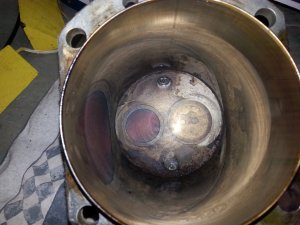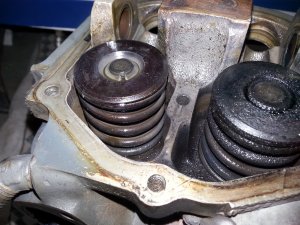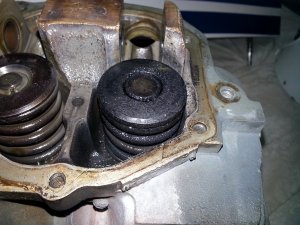Home › Forums › Maintenance of Grummans › Engine › Bad Exhaust Valve
Tagged: borescope, cylinder work, heat distress, Overheating
- This topic has 12 replies, 3 voices, and was last updated 8 years, 2 months ago by
Richard.
-
AuthorPosts
-
-
February 4, 2016 at 23:35 #3738
 Roscoe RoschéKeymaster
Roscoe RoschéKeymasterDuring the annual of Shop Monkey’s Cheetah, we had cylinder #3 only getting 18 psi on the compression test. That is 18 out of 80 or 18/80. You could hear the air hissing out the exhaust. So we straked the valve and got 20/80. Hummm. Looking at the bottom of the exhaust boss we saw pink. Okay, bad, heat. So we pulled the rocker cover to confirm a coked exhaust valve spring. Time for a new cylinder. This engine is factory original other than the carb having the pepper-box nozzle mod since the ‘Grumman Bump’ on first power reduction is very UNNERVING to some pilots.
This engine has 2013.52 on a first run engine. Nice right? So a new cylinder was installed and this O-320 will fly for probably another 200 hours before a major is needed, the engine will tell us. Here are the pictures on the old valve and the springs.

Here is how the failure ran its course. A valve wobble was done 493 hours ago (4 years). The guide wore, allowing the valve to cock and not seat properly allowing hot burning gas out and heat stressing the valve further. The hot gases got buy the guide and heated the upper valve stem and the exhaust springs so that the cooked oil on then (coking or a coked valve).
All other cylinders were normal in color and okay in compression. Rocker boxes were pulled and the 3 other exhaust valve were examined, all okay. The engine monitor (JPI 730) never showed any problems and the engine ran normally and made good power.
Notice in the bottom picture of the coked exhaust valve the missing paint on the fins and the pink under the rocker in the exhaust boss region. If you see this on your plane, or a friends, please investigate further. A new complete cylinder is just a few dollars over $1,000 ($1,030.22 UPS ground included) and Aircraft Spruce delivered it in 2 days (normal freight). We took our time, I was teaching as I swapped the cylinders but the total time was 3.5 hours. That had all the connections made, the baffles back, plugs and probes in, cowling on, etc. Your mileage may vary.
Cheers
Roscoe
Yankee-Aviation.com
513-519-7008 -
February 5, 2016 at 17:23 #3747
Barry Speronello
ParticipantRoscoe, how close do you think that valve was to failure? And if it still was showing good compression, was there any other symptoms? For example, what was the wobble for that valve when it got the wobble test 4 years ago and how did it compare to the others? What was the compression on that cylinder last year? Finally, did you look at that valve with a borescope while the cylinder was still installed and what did you conclude from that? Barry Speronello
-
February 6, 2016 at 00:01 #3751
 Roscoe RoschéKeymaster
Roscoe RoschéKeymasterBarry,
Have not taken it apart yet, but from the heat I guessing under 20 hours or so. At this point the forward it would have gone south in a hurry, most likely in flight with no warning. When we measured it, it was about 8 thousands total movement. It was tied with another exhaust valve. The others being 3 and 6 thousands in 1500 hour original cylinders.
Last year’s compression was 76/80. I did not look at it with a borescope. Like above, low compression got us here.
Roscoe
-
This reply was modified 8 years, 2 months ago by
 Roscoe Rosché. Reason: spelling and grammar
Roscoe Rosché. Reason: spelling and grammar
-
This reply was modified 8 years, 2 months ago by
 Roscoe Rosché.
Roscoe Rosché.
-
This reply was modified 8 years, 2 months ago by
-
February 6, 2016 at 19:14 #3754
Barry Speronello
ParticipantAs I read Lycoming SB388C it seems to say that the minimum passing wobble measurement is 0.010 inches (10 thousandths). The max passing is 0.035 inches (35 thousandths). But all 4 of the measurements done on that engine last year were under 10 thousandths and there was no red flag. So I must be reading the SB wrong. What are acceptable readings in the valve wobble test? Mine were measured last year at about 700 hrs SMOH and they were in the ballpark of 15-30 thousandths…but I’m not confident that our shop is really familiar enough with the test to give reliable results.
Is 30 thousandths in 700 hrs cause for concern?
-
February 7, 2016 at 16:42 #3764
Richard
ParticipantRoscoe,
I bet if that cylinder had been boroscope do at the last annual, the tale tell signs of heat distress on the face of the valve would of been noticed, leading to a boroscope check in the next 25 hrs, if not replacement at that time.
How many hours since the last annual and compression check?
-
February 7, 2016 at 18:10 #3765
 Roscoe RoschéKeymaster
Roscoe RoschéKeymasterYou would lose that bet. Matt checks his engine quite a lot. He looks for any reason when he see ‘funny’ data on the JPI as to what is going on with the engine.
There were 113 hours since the last annual where the last compression check was done.
-
February 7, 2016 at 18:38 #3766
Richard
ParticipantDoes he have a boroscope? With an engine at 2000 hrs, I would be doing a boroscope check of the valves every 50 hrs.
-
February 7, 2016 at 18:45 #3767
Richard
ParticipantAlso, you said the engine monitor showed nothing funny. Mike Busch has been collecting a lot of data from various engines that had heat distressed valve faces that shows a sawtooth pattern in the EGT. So that maybe an indicator of a valve problem if you analyze the EGT data carefully.
-
February 7, 2016 at 19:30 #3768
Richard
Participant -
February 8, 2016 at 20:03 #3769
 Roscoe RoschéKeymaster
Roscoe RoschéKeymasterYou should ping Shop Monkey. I suggested that he take the data from the couple of hours prior to the change and then a few hours of data after the change and send it to Mike for his analysis.
-
February 9, 2016 at 20:59 #3771
 Roscoe RoschéKeymaster
Roscoe RoschéKeymasterHere is the link to the scope we use. We also have an older one that uses a mirror to see backwards (badly).
-
February 16, 2016 at 16:35 #3835
Richard
ParticipantYah, it would be interesting to see the data on that specific cylinder to see if it has the telltale signs. From what I have gathered, an oscillation of EGT temps of between 25-75 degrees at about 1 ha, I believe is what Mike looks for. Without an analyzer and a good plotting routine, you won’t see it by just looking at the analyzer while in flight. Need to look post flight.
-
February 16, 2016 at 16:36 #3836
Richard
ParticipantThat’s the good one!
-
-
-
AuthorPosts
- You must be logged in to reply to this topic.

